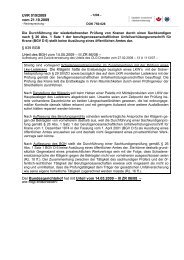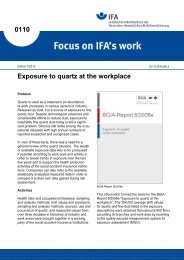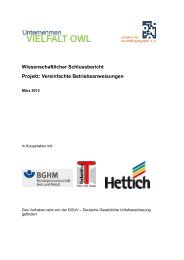Bericht über die Unfallmedizinische Tagung in Mainz am - Deutsche ...
Bericht über die Unfallmedizinische Tagung in Mainz am - Deutsche ...
Bericht über die Unfallmedizinische Tagung in Mainz am - Deutsche ...
Sie wollen auch ein ePaper? Erhöhen Sie die Reichweite Ihrer Titel.
YUMPU macht aus Druck-PDFs automatisch weboptimierte ePaper, die Google liebt.
V. Sitzung<br />
Ellenbogenverletzungen – Bewährtes und neue Trends<br />
Ellenbogenverletzungen – Bewährtes und neue Trends<br />
Vorsitz: A. Wentzensen, Ludwigshafen/R. Hoffmann, Frankfurt<br />
K. J. Burkhart, P. M. Rommens, L. P. Müller<br />
Lig<strong>am</strong>entäre Verletzungen und Luxationen des Ellenbogens<br />
Zus<strong>am</strong>menfassung:<br />
Die Ellenbogenluxation ist <strong>die</strong> zweithäufigste Luxation des menschlichen Körpers. Die<br />
Luxationsrichtung ist <strong>in</strong> 80–90% dorsoradial. Lig<strong>am</strong>entäre Begleitverletzungen s<strong>in</strong>d obligat.<br />
Aufgrund des Luxationsmechanismus von lateral nach medial, ist das LCL <strong>in</strong> 100% der Fälle<br />
rupturiert, gefolgt von der ventralen und dorsalen Kapsel. Das MCL rupturiert zuletzt und<br />
kann auch bei der vollständigen Luxation durchaus <strong>in</strong>takt bleiben. E<strong>in</strong>fache Luxationen<br />
werden nach e<strong>in</strong>er Ruhigstellung von wenigen Tagen <strong>in</strong> der Schl<strong>in</strong>ge oder im Oberarmgips<br />
<strong>in</strong> 90°-Beugung frühfunktionell therapiert. Die Prognose ist gut, <strong>die</strong> Reluxationsrate mit<br />
ca. 2% niedrig. Luxationsfrakturen dagegen müssen meist operativ versorgt werden. Die<br />
Prognose ist deutlich schlechter und abhängig von den knöchernen Begleitverletzungen,<br />
wobei Radiuskopf und Processus coronoideus von besonderer Bedeutung s<strong>in</strong>d.<br />
Schlüsselwörter:<br />
Ellenbogenluxation, Luxationsfraktur, Instabilität, Radiuskopf und Processus coronoideus<br />
Summary:<br />
The elbow dislocation is the second most dislocation of the human body. In 80–90% the<br />
elbow dislocates posteroradial. Injuries of the lig<strong>am</strong>ents are obligatory. Due to the dislocation<br />
mechanism from lateral to medial, the LCL is ruptured <strong>in</strong> 100% of the cases, followed by<br />
the dorsal and ventral capsule. The MCL tears at last and may stay <strong>in</strong>tact even <strong>in</strong> cases of<br />
complete dislocations. Simple dislocations are treated conservatively with immobilisation<br />
<strong>in</strong> a cast or sl<strong>in</strong>g for few days and adjacent physiotherapy. The prognosis is good and redislocation<br />
rate is low with approximately 2%. Dislocation fractures on the other hand have<br />
to be treated operatively <strong>in</strong> most of the cases. The prognosis is clearly worse and depends<br />
on the concomitant <strong>in</strong>juries, whereas the radial head and coronoid process are of particular<br />
importance.<br />
Keywords:<br />
elbow dislocation, fracture dislocation, <strong>in</strong>stability, radial head, coronoid process<br />
127

















